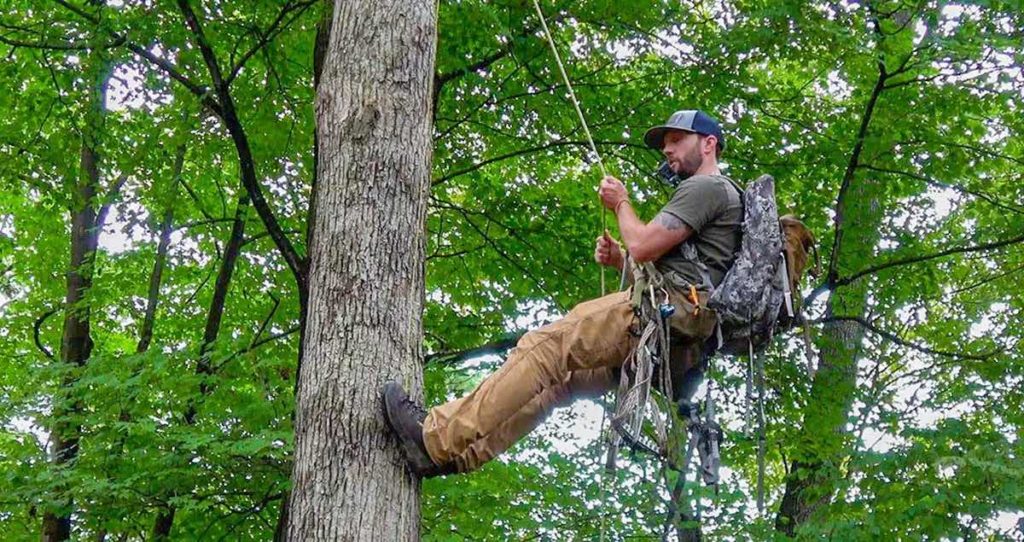A Complete Guide to One Stick Saddle Hunting
If you’re a saddle hunter looking to shave weight and take your mobility to the next level, then the one stick saddle hunting method may be the perfect option.
While it may seem a little extreme at first, one sticking is really not that difficult, and it certainly has its benefits. In this article, we’ll look at what one sticking is, what equipment is required, the pros and cons, and more.

What is One Stick Saddle Hunting?
One stick saddle hunting is a technique used by saddle hunters that involves climbing the tree using only one climbing stick, and then rappelling down at the end of the hunt.
If that sounds a little crazy to you, you’re not alone. That was my first thought when I heard guys discussing the one sticking technique. But after a lot of research, watching countless YouTube videos, and some testing of my own, it didn’t seem near as crazy. In fact, it’s pretty ingenious.
Is One Sticking Safe?
With the proper equipment and training, one stick saddle hunting is as safe as any other type of hunting from an elevated position. During the actual climbing process, it is actually safer because you are typically attached to the tree with both your lineman’s rope and the rappel rope.
The biggest difference is having to rappel down after the hunt, which we describe in detail below. This is where you will want to spend lots of time familiarizing yourself with your equipment and practicing at a safe height until you are comfortable with the process.
One Sticking Equipment
The Basics
One stick saddle hunting starts with much of the same basic equipment as traditional saddle hunting, like a hunting saddle and lineman’s rope. But you’ll also need some specialty gear just for one sticking, including:
- long rappel rope (30+ feet)
- long pull rope (30+ feet)
- a belay/rappel device like a Madrock Safeguard or a figure 8
- climbing stick with built-in platform (unless you plan to pack a separate platform)
- a multi-step aider
Ropes
For the rappel rope, you’ll want a high quality 3/8” static rope that is long enough to go around the tree at eye level while at hunting height and reach the ground. Most experienced one stick saddle hunters recommend using a 30- to 40-foot rope for the job.
The pull rope is used to pull down your rappel rope after you reach the ground. It doesn’t need to be heavy, because it doesn’t support you in any way. In fact, it can be the same rope you use to raise and lower your bow, crossbow or rifle. Make sure your pull rope is as long as your rappel rope.
MadRock Safeguard or Figure 8
When you rappel down after the hunt, you need a way to slow your descent. That’s where the Madrock Safeguard or a figure 8 device come into play.
The Madrock is a mechanical device that connects your saddle’s bridge rope to the rappel rope via a carabiner. There is a handle on the device that, when pulled, releases tension on the rope so you can descend. The further out you pull the handle, the quicker you get to the ground.
The figure 8 device serves a similar function, but is not mechanical. It’s just a metal figure 8 that you weave your rappel rope through in a way that it creates enough tension to slow down your descent.
I would personally recommend starting with the Madrock as you learn the ropes of one sticking, then you can experiment with other equipment like a figure 8.
Climbing Stick With Platform
As the technique name implies, you’ll only need one climbing stick. And while any climbing stick will do, most one stick saddle hunters use one with a small, built-in platform. That kills two birds with one stone by eliminating the need for a separate platform.
If you prefer a little more foot room in the tree, you can always use a standard climbing stick and a separate platform like traditional saddle hunters. You won’t shave off as much weight, but you’ll still be two to three sticks lighter.
Aider
To get the most distance out of each move of your single climbing stick, you’ll likely want to add an aider. If you’re unfamiliar with an aider, it’s a small nylon or rope ladder with anywhere from one to 4+ steps. It attaches to your climbing stick, allowing you to climb a greater distance than the stick alone, with minimal weight added to the setup.
I would recommend a two-step aider for one sticking, as it gives you a little more climbing distance over a one-step aider. Anything over two steps is a waste for one stick saddle hunting because you won’t be able to use the third or fourth step other than your first move up the tree.
The One Sticking Technique
Now that you know what equipment you’ll need to one-stick, you’re probably wondering how it all works together to get you up to hunting height and back down.
The best way to get a full grasp of the process is by watching someone do it, so I’ve included a YouTube video below from Clint Campbell of the Truth from the Stand podcast that will walk you through the process step-by-step.
But if you prefer to read about the process over watching it, I’ll do my best to explain. Here are the five steps needed to climb a tree using the one stick saddle hunting method:
- Attach your climbing stick to the tree at a height where you can easily lift your foot up to the first step.
- Before you take that first step off the ground, make sure you are secured to the tree with a lineman’s rope.
- Climb to the top of your climbing stick, secure yourself to the tree by attaching the bridge rope on your saddle to the long rappel rope, and step off the side of the stick and allow yourself to hang in your saddle just off the side of the tree.
- Reach down and grab your climbing stick, remove it from the tree, bring it up as high as you can, and secure it back to the tree.
- You can then climb back onto the stick and to the top, repeating the process until you reach hunting height.
Rappelling Down
The thought of rappelling down the tree from hunting height is what worries most would-be one stick saddle hunters. It seems a little extreme, but it’s really a simple process, and much easier than having to climb down while removing a platform and multiple sticks.
Here are the specific steps to getting back to the ground when you one stick.
- Lower your bow or firearm to the ground with your pull rope, then attach the end in your hand to the loop or carabiner on the end of your rappel rope.
- Hold onto your rappel rope with your non-dominant hand and use your dominant hand to control the speed of your descent using the rappelling device. Keep your feet apart and your body upright.
- Continue descending: Keep your weight evenly distributed between your feet and control your descent speed with the rappelling device until you reach the bottom.
- Once you reach the ground, you can unhook your saddle from the rappel rope, and use the pull rope to pull the loop or carabiner on the end of the rappel rope away from the tree. As you do, the rope should open up from around the tree and drop to the ground.
That’s it. Again, if you haven’t actually seen someone one stick, either in person or on a YouTube video, then my description is probably hard to envision. That’s why I’ve included the video above to help you fully understand the process.
Pros/Cons of One Sticking
Is the effort to learn and master a completely foreign saddle hunting technique worth the hassle? Only you can answer that for yourself, but let’s take a quick look at the pros and cons of one sticking to help you decide.
PROS
- Less equipment to haul
- Significant weight savings
- It’s just cool!
CONS
- Steeper learning curve
- Longer ropes to manage
- Requires some specialty gear
Final Thoughts
One stick saddle hunting is not for everyone. But if you’re a serious saddle hunter who likes to stay as light and mobile as possible, then it may be the perfect technique for you.
If it has piqued your interest, I would encourage you to find someone local who one sticks so they can demonstrate and possibly walk you through the process. You may be surprised at how quickly you adapt and identify as a one stick saddle hunter!

Aiders: the only caveat to what you say is that I’ve used the one stick with three step aider as the only move in thicker areas. I’m sure it can be done with the two step, but just my two cents.